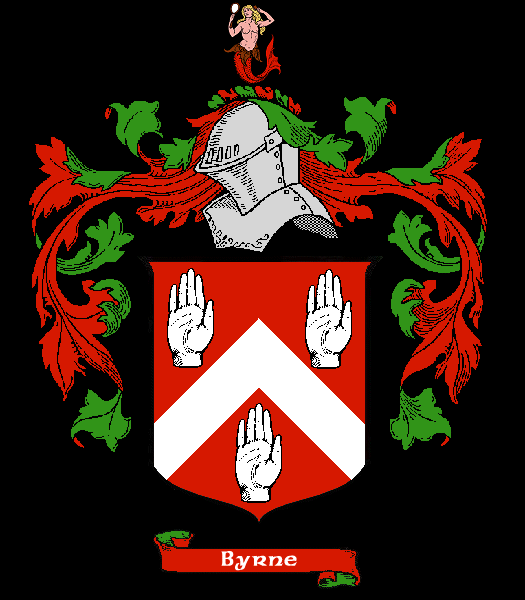 O'Byrne is in Irish O Broin I.e. descendant of Bran (earlier form Broen),
King of Leinster, who died in 1052. With the O'Tooles and the O'Byrnes were driven from
their original territory in the modern Co. Kildare at the time of the Anglo-Norman
invasion and settled in the wilder country of south Wicklow about the year 1200. There
were two main branches of the O'Byrnes of which the senior soon sank into obscurity, but
the junior line, which occupied the country between Rathdrum and Shillealagh, became a
sept of great importance and, like their neighbours the O'Tooles in north Wicklow, were
particularly noteworthy for their persistent and largely successful resistance to English
aggression. They continued regularly to inaugurate chiefs of the sept up to the end of the
sixteenth century. The seat of their chiefs was at Ballinacor and their territory was
called Crioch Branach, the sept itself being known as Ui Broin or Branaigh. Many of these
were renowned in the military history of Ireland, the most famous being Feagh or Fiacha
MacHugh (or son of Aodh) O'Byrne (1544-1597) who, though he was prominent in rebellion and
was killed in battle, is perhaps best remembered for his part in the escape of Hugh Roe
O'Donnell from his prison in Dublin Castle in 1591. His son Phelim O'Byrne was the victim
of one of the many unscrupulously trumped-up charges which disgraced English seventeenth
century administration in Ireland: the Viceroy Falkland was in turn disgraced, but
notwithstanding that the O'Byrnes lost the greater part of their estates in consequence of
his action. The celebrated "Leabhar Branach" or "Book of the O'Byrnes"
is a collection of Gaelic poetry by some thirty-five different authors, dealing for the
most part with the exploits and personalities of the O'Byrnes in the sixteenth century: it
was made about 1662. In the next century O'Byrnes were prominent in the 1798 insurrection,
notably the brothers Garret O'Byrne (1774-1830) and William Byrne (1775-1799), the latter
of whom was hanged; and Miles Byrne (1780-1862), who subsequently distinguished himself in
France and was awarded the Legion of Honour. Other O'Byrnes have been notable in France:
one branch, which was admitted to the ranks of the French nobility in 1770, was a leading
family of Bordeaux before the Revolution and Garret Byrne, mentioned above, was among the
distinguished exiles to that country; while in America, Irish-born Most Rev. Dr. Andrew
Byrne (1802-1862), first bishop of Little Rock, is remembered as a pioneer Catholic in
Indian territory. In recent times one of the best known and most popular figures in the
life of the Irish capital was Alderman Alfred Byrne (1882-1956), who was ten times Lord
Mayor of Dublin. The Byrnes, who in recent generations have increasingly resumed the
discarded prefix O, are very numerous in Ireland to-day, the name being in the seventh
place in the list of Commonest Names. The great majority of these were born in Dublin, in
Co. Wicklow and adjacent counties. O'Byrne is in Irish O Broin I.e. descendant of Bran (earlier form Broen),
King of Leinster, who died in 1052. With the O'Tooles and the O'Byrnes were driven from
their original territory in the modern Co. Kildare at the time of the Anglo-Norman
invasion and settled in the wilder country of south Wicklow about the year 1200. There
were two main branches of the O'Byrnes of which the senior soon sank into obscurity, but
the junior line, which occupied the country between Rathdrum and Shillealagh, became a
sept of great importance and, like their neighbours the O'Tooles in north Wicklow, were
particularly noteworthy for their persistent and largely successful resistance to English
aggression. They continued regularly to inaugurate chiefs of the sept up to the end of the
sixteenth century. The seat of their chiefs was at Ballinacor and their territory was
called Crioch Branach, the sept itself being known as Ui Broin or Branaigh. Many of these
were renowned in the military history of Ireland, the most famous being Feagh or Fiacha
MacHugh (or son of Aodh) O'Byrne (1544-1597) who, though he was prominent in rebellion and
was killed in battle, is perhaps best remembered for his part in the escape of Hugh Roe
O'Donnell from his prison in Dublin Castle in 1591. His son Phelim O'Byrne was the victim
of one of the many unscrupulously trumped-up charges which disgraced English seventeenth
century administration in Ireland: the Viceroy Falkland was in turn disgraced, but
notwithstanding that the O'Byrnes lost the greater part of their estates in consequence of
his action. The celebrated "Leabhar Branach" or "Book of the O'Byrnes"
is a collection of Gaelic poetry by some thirty-five different authors, dealing for the
most part with the exploits and personalities of the O'Byrnes in the sixteenth century: it
was made about 1662. In the next century O'Byrnes were prominent in the 1798 insurrection,
notably the brothers Garret O'Byrne (1774-1830) and William Byrne (1775-1799), the latter
of whom was hanged; and Miles Byrne (1780-1862), who subsequently distinguished himself in
France and was awarded the Legion of Honour. Other O'Byrnes have been notable in France:
one branch, which was admitted to the ranks of the French nobility in 1770, was a leading
family of Bordeaux before the Revolution and Garret Byrne, mentioned above, was among the
distinguished exiles to that country; while in America, Irish-born Most Rev. Dr. Andrew
Byrne (1802-1862), first bishop of Little Rock, is remembered as a pioneer Catholic in
Indian territory. In recent times one of the best known and most popular figures in the
life of the Irish capital was Alderman Alfred Byrne (1882-1956), who was ten times Lord
Mayor of Dublin. The Byrnes, who in recent generations have increasingly resumed the
discarded prefix O, are very numerous in Ireland to-day, the name being in the seventh
place in the list of Commonest Names. The great majority of these were born in Dublin, in
Co. Wicklow and adjacent counties.
Click here
to start reading about our O'Byrne clan. |
![]()